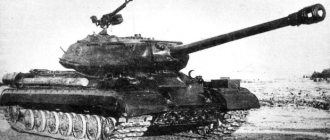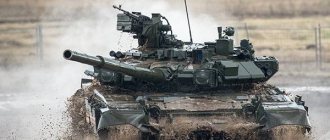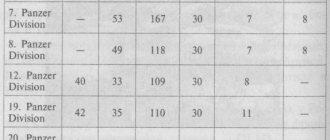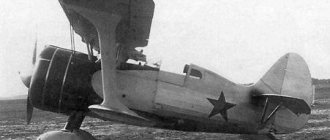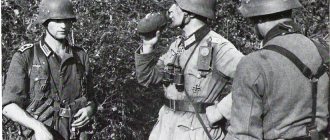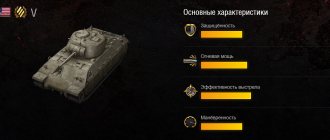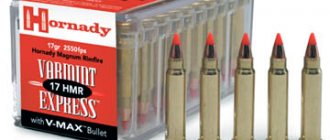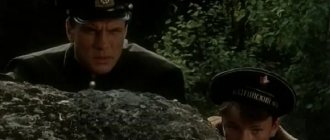Home » Real story » Little-known and unrealized projects of tanks and other armored vehicles » German versions of the T-34 conversion
Little-known and unrealized projects of tanks and other armored vehicles Unrealized projects of tanks of the Third Reich and Germany.
boroda 12/10/2018 4078
13
in Favoritesin Favoritesfrom Favorites 8
This material was already on the site once. But then it disappeared during a collapse in 2010. So I decided to restore it specifically in order to insert it into the book T-34 - the best tank of the Second World War .
As you know, throughout the war, both sides of the conflict managed to capture quite a large number of trophies, including tanks. And both sides tried to use them in their armies. Ours were in somewhat smaller quantities, but the Germans tried not to lose a single more or less combat-ready vehicle. But this is understandable, at the end of the war in Germany every tank counted, and the famous German frugality, I think, is also known to everyone.
I present to your attention some options for converting our tanks by the Germans. I want to immediately explain the need for these alterations. The fact is that Germany did not produce ammunition for our weapons, and therefore, in order to use the captured equipment, the easiest option was to exchange our weapons for our own.
Tank T-34-88.
Such machines were produced in the summer of 1944 at the plant in Libau. Supposedly 18 of them were made. Instead of our 85 mm gun, these vehicles were equipped with 88 mm guns from damaged Tigers. From the end of 1944 this tank was used in Courland in the 12th Panzer Division. The color of the tank did not change. For better identification, a large cross was painted on the tower.
Tank T-34-88.
Tank T-34-88.
Slanted armor
The reader could see that with respect to the B-2, German tank engines developed in their own way, and the “Panther” from Daimler-Benz does not in any way resemble a copy of Soviet tanks, not to mention the MAN project. But the influence of the T-34 on the development of armor protection is rather underestimated, which is quite strange. Some kind of shaftless gearbox hidden inside is one thing; the hull and turret, the geometry of which largely determines the appearance of the tank, is another thing. But first things first.
The Germans, of course, knew about the sloped armor even before examining the T-34. Back in the 30s, they developed a whole range of hulls with armor plates at rational angles for wheeled and tracked vehicles. As an example, let’s take the Sd.Kfz.252 light ammunition carrier, mass production of which began in 1940. The appearance of the 7.5-cm Selbstfarlafette L/40.8 half-track tank destroyer, work on which began back in 1934, is even more expressive. Due to the active use of reverse slope armor, its hull is somewhat reminiscent of late Soviet heavy tanks.
The appearance of the 7.5-cm Selbstfarlafette L/40.8 speaks for itself
With all this, German tanks of the same period are described by the phrase “box on box”. For a long time, the Germans skimped on armor in favor of light weight and high mobility, so early German tanks were protected only from bullets and shrapnel, and there was no point in experimenting with geometry. But the engineers conveniently arranged the components and, as it seemed to them, rationally used the internal volume of the case.
In addition, the hulls of many early German tanks consisted of several parts: a lower bathtub (Wanne) and an upper superstructure (Aufbau), as well as a superstructure over the engine compartment. This simplified the assembly of the tank and its overhaul. Let's take the production of Pz.Kpfw.III. First, the suspension, engine, transmission and other units were mounted on the bathtub, and only then a superstructure with a tower was placed on top. Of course, this is much simpler than pushing the transmission through the turret ring, and minor modifications to the hull are required when creating self-propelled guns: you just need to replace the turret superstructure with the wheelhouse. However, this scheme is not compatible with the T-34 type hull, since the upper inclined armor plates will disrupt the vulnerable joint.
Assembly of Pz.Kpfw.III Ausf.G on
Gradually the Germans switched to solid hulls. Already on VK 30.01 (H) and VK 36.01 the superstructure was made integral with the “bathtub”, but engineers, out of habit, followed the old forms. Moreover, they developed viewing devices and machine gun mounts for armor installed at a slight angle of 9°. Only acquaintance with the T-34 pushed German engineers to reassess their approach. It cannot be said that since the Germans did not use inclined armor on tanks, they did not know about it, because if they knew, they would definitely put their knowledge to use. One can cite many cases of how a clear example prompted use. For example, in the USSR they switched to welded hulls after becoming familiar with German welded structures. Does this mean that in the entire Soviet Union no one could have guessed that two pieces of metal could be welded with an electrode? Of course not. Here we see a similar case.
The impact of the T-34 on different companies was different. The MAN VK 20.02 has a distinctive hull with sloping armor. The hull of the Panther from Daimler-Benz looks quite similar to the T-34, but with a number of significant differences. But I was deeply impressed by the Soviet tank. It is worth noting that we are talking about the early T-34, whose frontal part of the turret was made of a solid bent armor plate - initially the frontal part of the hull was also made bent, but this was quickly abandoned. This point was of great interest to Krupp engineers. For example, the front of the Tiger H1 hull consisted of four armor plates, while the Tiger P had six. If the frontal part is made from just one bent sheet, then assembly can be simplified and the number of welds can be reduced to a minimum.
Projection of the forehead of a heavy tank Pz.Kpfw. Lowe. Please note: the entire forehead of the body is made of one piece, bent in two places
Krupp engineers already had experience using bent armor plates. Even when developing the VK 30.01 (P), they proposed a cylindrical turret in which the sides and rear were made of a single horseshoe-shaped bent sheet. It is not surprising that after examining the T-34 they decided to widely implement this idea. Already in January 1942, Ferdinand Porsche proposed redesigning the Tiger P's hull with sloped armor. In response, I prepared a hull design for the VK 45.02 (P) with a single bent frontal part installed at an angle of 55°. The transition to a new hull was planned for the 101st tank, but due to the suspension of Tiger P assembly, it never took place. Around the same time, the hull of the super-heavy Löwe was also redesigned by analogy - it also received a forehead from a single bent armor plate.
The significant impact of the T-34 on the tank department was largely ignored for a long time. You can still find drawings and models of VK 45.02 (P) and Löwe with a frontal part of the hull made of upper and lower armor plates with a welded seam. Meanwhile, there is no seam in the drawings, and the part was assumed to be solid.
Tank T-34-75.
This tank also fought in Courland. The number of such machines is unknown. As you can see, this tank was based on one of the first modifications of the T-34 from 1941. This vehicle was equipped with a German short-barreled 75 mm KwK 37 (L/24) gun from the PzKw IV tank instead of our 76 mm cannon.
Tank T-34-75
Tank T-34-75
ZSU T-34-88
As far as we know, this version of the alteration existed in a single copy. It was done by a certain Ernest Albert, chief mechanic of the 286th SS Infantry Regiment. As you can see, an 88 mm anti-aircraft gun was installed on the T-34 chassis, which was a formidable weapon both in the fight against armored vehicles and aircraft. This vehicle was part of the 286th SS Infantry Regiment and was captured in April 1945 near Frankfurt an der Oder.
ZSU T-34-88
ZSU T-34-88
ZSU T-34-88
ZSU T-34-88
ZSU T-34-20.
This alteration was also carried out by Ernest Albert for his unit. On this vehicle, instead of a standard turret, a platform with three 20 mm automatic cannons was mounted. The car was also captured in the southwest of Frankfurt an der Oder.
ZSU T-34-20
ZSU T-34-20
ZSU T-34-20
ZSU T-34-20
Towers: before and after
The early T-34 influenced German tank building not only with its hull shape, but also with its approach to turret design. This issue deserves a separate analysis. For a long time, the Germans created tank turrets quite simply: they more or less evenly “covered” the turret ring with armor on all sides, so early turrets, when viewed from above, resembled a square or cylinder with a wide frontal part.
One of the first T-34s built. Both the turret forehead and the hull forehead are made of solid bent armor plates
The turret of the early T-34s was completely different - with a narrow frontal section, a small gun mantlet and a rear niche. These decisions were very relevant for the Germans, who actively used differentiated armor. It is clear that the weight of the armor depends on the thickness of the sheet and its area; This means that if you reduce the area of the thickest armor plates to a minimum, then, all other things being equal, you can lighten the tank. The thickest armor is usually in the forehead, so the narrow frontal part of the T-34 turret attracted the attention of German designers. They also took a closer look at the rear niche: it not only balanced the tank guns, which were becoming larger and heavier, but was also a suitable place for the first-stage ammunition stowage.
Having examined the early T-34, Krupp engineers experienced an unprecedented catharsis and largely revised their understanding of the towers. As a result, the VK 45.02 (P) turret combined the best Soviet and German ideas: sloped armor, a curved forehead with minimal area, a compact gun mantlet, a developed rear niche with ammunition racks and a new commander's turret with periscopes instead of slits. Despite the installation of a heavier gun, increased armor protection and the presence of ammunition racks, the VK 45.02 (P) turret was only two tons heavier than the old Tiger P1 and H1 turret - that’s how important thoughtful geometry is! By analogy, Krupp also designed turrets for early versions of the Maus. Even in the final version, the turret built in metal had its forehead made in the form of a single bent part, similar to the early T-34.
Drawing of an early tower VK 45.03. It differs from the VK 45.02 (P) turret by replacing the electric drive with a hydraulic one
However, not everything was so rosy. When assembling the early VK 45.02 (P) turrets, 8 out of 15 frontal parts cracked. Although their contours looked beautiful on paper, manufacturability was questionable. Meanwhile, the requirements for protection grew and grew, so Krupp increased the thickness of the frontal part to 180 mm and abandoned the bent shape. This is how the “Royal Tiger” turret appeared, and the old turrets with a 100-mm forehead were used for the first 50 tanks.
for VK 30.01 (D) she also designed a turret similar to the T-34, with a narrow frontal part and a small gun mantlet. Unlike Krupp, it bypassed the rake and opted for a flat frontal piece from the start. In general, the Daimler-Benz turret was more progressive than that of Rheinmetall, but work on it was carried out with a delay of 3-4 months, and their shoulder straps were incompatible (1600 mm versus 1650 mm). Therefore, it was abandoned, and the production “Panthers” received a “Rheinmetall” turret with a wide frontal part.
This is what Panther II would look like with a new turret. As you can see, the gun mantlet has been completely redesigned compared to the regular Panther turret. In the Schmalturm turret, the frontal part has become even narrower
And yet the new approach won. On Panther II, the turret design was redesigned, narrowing the frontal area and completely redesigning the mantlet. This tower is known as Turm-Panther (Schmale Blende), that is, “tower with a narrow mask.” When the design of a new medium tank reached a dead end, the developments on the turret were transferred to Daimler-Benz.
She developed her old ideas and designed a rather successful Schmalturm tower, i.e. "narrow tower" It was cheaper and more technologically advanced than the standard Panther turret, weighed 100 kg less with better protection (the forehead was 20 mm thicker, the sides and rear were 15 mm thicker) and included the installation of a rangefinder. However, work on it began too late, so the Germans never had time to move on to production of the Pz.Kpfw.V Ausf.F with new turrets.
The VK 16.02 turret was created with an eye to the early T-34, this is especially noticeable in the top view
In addition, with an eye to the early T-34, Daimler-Benz developed a turret for the VK 16.02 light tank. Later they wanted to install it on the Lux reconnaissance tank, but these ideas remained on paper. But a lightweight version of this turret found its application on the Sd.Kfz.234 armored car. The conclusion is obvious: the impact on the development of the towers was very significant.
